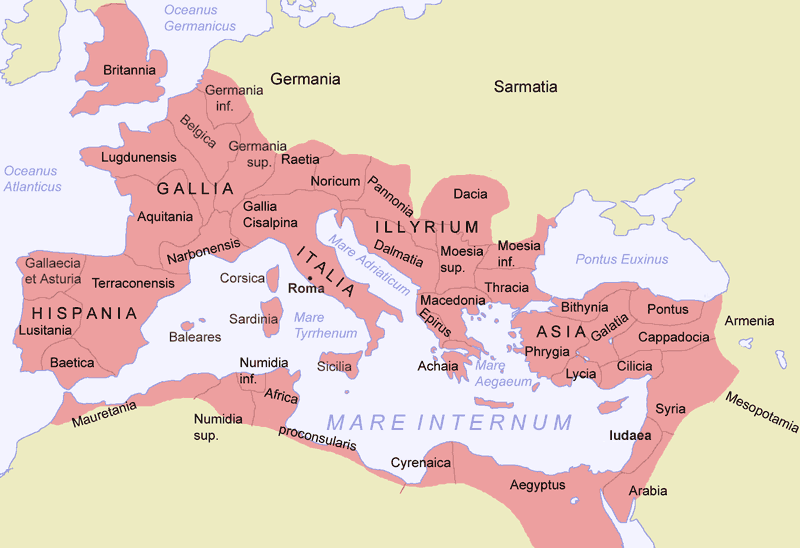24. The Roman Empire (27 BCE – 395 CE)
Summary After the Roman Republic already had gained the rulership of large parts of the Mediterranean Basin, Augustus founded the Roman Empire in 27 BCE. The Roman Empire stretched from the Iberian Peninsula in the west to Syria in the east, and from Egypt in the south to Britain in the north. Christianity became its state religion in 380 CE, the empire was split into a western and an eastern part in 395 CE, and the western part was ultimately conquered by Germanic tribes in 476 CE.
Keywords Augustus; Christianity; History of the Mediterranean Basin; History of Western Europe

A map of the Roman Empire in 117 CE. It stretched from the Iberian Peninsula in the west to Syria in the east, and from Egypt in the south to Britain in the north. (© User:Jniemenmaa / Wikimedia Commons / CC-BY-SA-3.0)
Similar to Han China in the east, in the very west of the Eurasian landmass the Roman Republic became the dominant political power in the Mediterranean Basin. Rome was a major political power since the late 4th century BCE and had whole Italy and Spain conquered in 218 BCE. The Carthagian Empire, its opponent based in today’s Tunisia, was defeated in the three Punic Wars (264-241 BCE, 218-201 BCE, 149-146 BCE). As Rome’s realm of influence grew, its republican constitution was then undermined by a series of civil wars since 133 BCE. They led to the dictatorship of Julius Caesar (49-44 BCE) and to the rulership of Augustus from (27 BCE – 14 CE). Augustus was the first Roman emperor and brought peace back to the newly formed empire, the Pax Romana which would last until 180 CE. Around that time Rome rapidly expanded its borders: Asia Minor was conquered from the Pontic Kingdom in 63 BCE, France from Gallic tribes in 51 BCE, Ptolemaic Egypt in 30 BCE, Judea from the Jews in 6 CE, and Britain from Celtic tribes in 43 CE. The months July and August are named after Julius Caesar and Augustus, and the German (Kaiser) and the Russian (Tsar) names for emperor were derived from the name of Julius Caesar.

A statue of the first Roman emperor Augustus (r. 27 BCE – 14 CE). His reign is seen as the beginning of a long time of peace and prosperity in the Roman Empire, the Pax Romana, which lasted until 180 CE. (© Photographed by Till Niermann / Wikimedia Commons / Public Domain)
Rome was the biggest city in the world from around 100 BCE to 400 CE, and it is believed to be the first city which ever reached one million inhabitants. In 1 CE the population of the Roman Empire was about 60 million, constituting about 20% of the world population and being equal to the one of Han China. Trade routes flourished – sought-after goods in Rome were for example silk from China and spices from southern India. The Roman Empire reached its largest geographical extent under emperor Trajan (r. 98-117 CE) when it stretched from the Iberian Peninsula in the west to Syria in the east, and from Egypt in the south to Britain in the north. Rome often fought wars in the east against the Parthian Empire (247 BCE – 224 CE) and the Sasanian Empire (224-651 CE) in Iran, which were successors of the Persian Achaemenid Empire and the only true empires in Rome’s immediate surrounding.
Christianity, which is based on the teaching of the Jewish preacher Jesus (about 4 BCE – 30 CE), became state religion in 380 CE during the rule of Constantine the Great, and in 395 CE the Roman Empire was split into a western and an eastern part. The Western Roman Empire perished in 476 CE when it was conquered by Germanic tribes who in turn fled from the Huns. While this event is traditionally seen as the end of the main string of Roman history, the Eastern Roman Empire – which is also called the Byzantine Empire and the capital of which was Constantinople – still flourished for a long time. It ruled large parts of the Mediterranean Basin including Syria, Egypt, Tunisia and Italy under Justinian the Great in the 6th century. However, it was weakened by the wars with the Sasanian empire in the 7th century and then lost many territories to the advancing Arabs during the Islamic conquests. After that its extent was limited to Anatolia and southeast Europe, however it remained to be a center of culture, education and economic wealth. It continued to exist until 1453 when it was ultimately conquered by the Turkish Ottoman Empire. Apart from the Byzantine Empire, another continuation of the Roman Empire was the so-called Holy Roman Empire in central Europe which was established in 962 by the papal coronation of German King Otto the Great, and which lasted until 1806 during the Napoleonic Wars.
